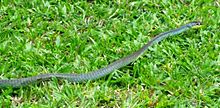| Dendrelaphis calligaster | |
|---|---|

| |
| Conservation status | |
 Least Concern (IUCN 3.1) | |
| Scientific classification | |
| Domain: | Eukaryota |
| Kingdom: | Animalia |
| Phylum: | Chordata |
| Class: | Reptilia |
| Order: | Squamata |
| Suborder: | Serpentes |
| Family: | Colubridae |
| Subfamily: | Ahaetuliinae |
| Genus: | Dendrelaphis |
| Species: | D. calligaster |
| Binomial name | |
| Dendrelaphis calligaster (Günther, 1867) | |
| Synonyms | |
| |
Dendrelaphis calligaster, also called green tree snake, northern green tree-snake, and northern tree snake, is a colubrid snake native to New Guinea, Australia, and Solomon Islands. It is a slender, large-eyed, non-venomous, diurnal snake, which grows up to 1.2 m in length and is greenish, brown, or greyish above with a cream or yellow belly.
This common snake is harmless, and readily recognised due to its cream to yellow belly and pronounced wide dark facial stripe passing across the eye.
Etymology
The specific name calligaster means "beautiful-bellied".
Distribution and habitat

In Australia, Dendrelaphis calligaster are found on the eastern side of the Cape York Peninsula (Queensland) as far south as Mackay. On the western side, their range is poorly mapped. They also occur on many of the Torres Strait Islands. On the New Guinea mainland, they are widespread at elevations below 1,150 m (3,770 ft) in both Indonesian and Papua New Guinean parts of the island. They occur also on many nearby islands. The Reptile Database also lists this species from the Solomons.
Dendrelaphis calligaster is primarily arboreal but can also forage on the ground. It can be found in rainforest, mangroves, dense secondary regrowth, and tropical woodlands. It is abundant throughout its range.
Behaviour and ecology
They eat frogs and reptiles.
Breeding
The northern tree snake lays five to seven eggs in clutches, with one female recorded as laying 11 eggs in January.
References
- ^ Tallowin, O.; Allison, A.; O'Shea, M.; Parker, F.; Hoskin, C.; Vanderduys, E.; Amey, A.; Couper, P. & Cogger, H. (2018). "Dendrelaphis calligaster". IUCN Red List of Threatened Species. 2018: e.T116827083A1445157. doi:10.2305/IUCN.UK.2018-1.RLTS.T116827083A1445157.en.
- ^ Dendrelaphis calligaster at the Reptarium.cz Reptile Database. Accessed 19 March 2024.
- ^ Queensland Museum (2000). Wildlife of Tropical North Queensland: Cooktown to Mackay. ISBN 0-7242-9349-3.
- ^ Ehmann, H. (1992). Encyclopedia of Australian Animals: Reptiles. The Australian Museum, Angus & Robertson. ISBN 0-207-17379-6.
- "Northern tree snake". Reptiles Down Under – Australian Reptile Studies. 2008. Archived from the original on 29 November 2010.
External links
| Taxon identifiers | |
|---|---|
| Dendrelaphis calligastra | |
| Dendrelaphis salomonis | |